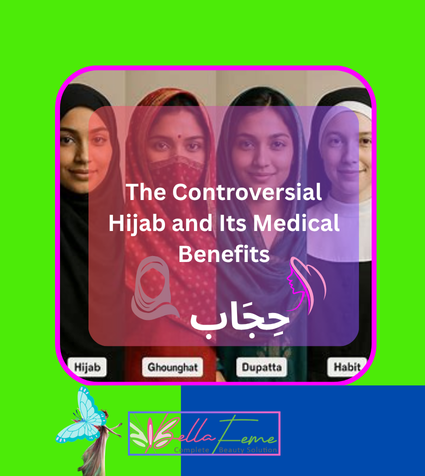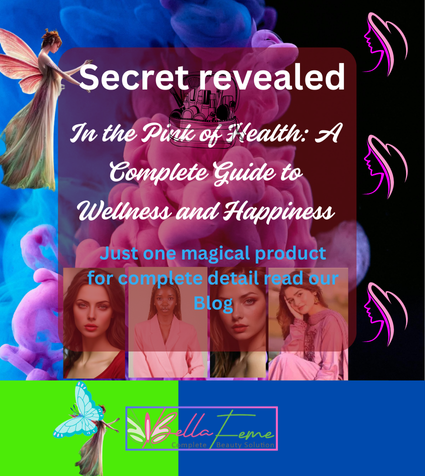Hijab Debate: Exploring Its Medical and Health Benefits
Dear Readers,
At BellaFeme, we honor and celebrate every woman. Our blog is dedicated to providing complete solutions for beauty, wellness, and health because every woman deserves to feel confident, strong, and beautiful.
Cultural Comparison: Hijab, Ghoonghat, Dupatta, and Habit
Whenever the word hijab is mentioned, it is often immediately associated with Muslim women and Islamic culture. Traditionally, the hijab is both a religious and cultural symbol of modesty and faith. However, in the modern era especially after the events of 9/11 and the rise of global social media many people in the West have started to read about and explore Islam more deeply.
Unfortunately, some mainstream and electronic media outlets have contributed to misunderstandings by portraying a negative image of women from the Gulf countries, India, and Pakistan who choose to dress modestly or cover themselves. These portrayals often ignore the personal, cultural, and spiritual significance of the hijab, reducing it to a symbol of oppression rather than recognizing it as an expression of faith, dignity, and personal choice.
Modesty is a universal value shared across religions, cultures, and generations. Whether it’s the Hijab in Islam, the Ghoonghat and Dupatta in South Asian culture, or the Habit worn by Christian nuns, all serve the same purpose: to express dignity, purity, and self-respect through modest dress. Today, modest clothing is no longer confined to one faith. Across the world even in the West people are rediscovering the beauty of dressing with decency and grace.
1.Definition
Before diving deeper, let’s clear one common misconception the hijab is not limited to Muslims.
The term “Hijab” in Arabic literally means “barrier” or “covering.” It refers to any form of clothing that covers the human body modestly, for both men and women.
In simple terms, Hijab = Modesty.
It can be a headscarf, dupatta, ghoonghat, veil, or even a full outfit like a three-piece suit that covers the body appropriately.
Every culture has its own version:
- Hijab: Islamic modest dress covering the hair and body.
- Ghoonghat: Traditional Indian or South Asian veil.
- Dupatta: A long scarf worn modestly with traditional outfits.
- Habit: Religious garment worn by Christian nuns as a symbol of devotion.
Each represents self-respect, modesty, and discipline in its own context.
2. Religion
So, modest clothing is not oppression it’s an act of faith and identity across all traditions.
Every major religion encourages modesty not just Islam.
- Islam: The Qur’an instructs both men and women to lower their gaze and dress modestly (Surah An-Nur 24:30–31).
- Christianity: In the Bible, 1 Corinthians 11:5–6 speaks about women covering their heads during prayer as a sign of respect and devotion.
- Hinduism: The Ghoonghat or Dupatta symbolizes humility, grace, and family honor.
- Sikhism: Modesty in dress and behavior is part of self-respect and discipline.
- Benefits of Modesty (Hijab, Ghoonghat, Dupatta, Habit)
🌿 Physical and Medical Benefits
- Protects skin from harmful UV rays and pollution.
- Reduces exposure to dust and allergens, supporting respiratory health.
- Prevents sunburn and premature aging of the skin.
- Helps maintain body temperature in both hot and cold weather.
🧠 Psychological and Emotional Benefits
- Encourages self-confidence and inner peace.
- Reduces anxiety linked to body image or societal pressure.
- Promotes spiritual mindfulness and respect in social interactions.
💫 Social and Cultural Benefits
- Reflects discipline, dignity, and equality.
- Reduces objectification by shifting focus from appearance to personality.
- Strengthens a person’s spiritual identity and moral values.
10 Scientifically Proven Medical Benefits of Wearing Hijab for a Healthier Mind and Body
Understanding the Hijab: More Than a Cultural Symbol
The hijab, often viewed as a cultural or religious garment, is also a protective layer that offers several health advantages. Beyond modesty, it serves physiological, psychological, and environmental functions. Medical research suggests that covering parts of the body, especially the head and neck, can shield individuals from various physical and mental health issues.
For many women, wearing the hijab provides comfort, identity, and self-assurance. But lesser-known are its tangible medical benefits from UV protection to improved respiratory health.
Skin Protection from Harmful UV Rays
The hijab acts as a natural barrier against the sun’s ultraviolet (UV) radiation. Continuous exposure to UV rays can cause sunburn, hyperpigmentation, and even skin cancer. By covering the head, neck, and shoulders, hijab wearers significantly reduce their exposure to harmful sunlight.
Reduced Risk of Skin Cancer
Dermatological studies confirm that UV radiation is the leading cause of skin cancer. A hijab, especially when made of tightly woven fabrics like cotton or linen, offers an SPF-like protection that reduces direct sun impact. Women who wear hijab daily often report fewer cases of sun-induced skin irritation or freckles compared to non-hijab wearers.
Prevention of Premature Aging
Sun exposure accelerates the breakdown of collagen, leading to wrinkles and early aging. By shielding facial skin from sunlight, the hijab slows this process naturally, helping maintain youthful, healthy-looking skin without the need for chemical sunscreens.
Temperature Regulation and Heat Protection
Contrary to popular belief, wearing a hijab can actually help regulate body temperature. In hot climates, light-colored and breathable hijabs reflect sunlight, keeping the head cooler. In colder environments, thicker fabrics like wool provide insulation against chill.
Protecting the Scalp and Hair from Heat Damage
Direct sunlight can dry out the scalp, leading to dandruff, brittle hair, and split ends. A hijab prevents excessive exposure to heat, maintaining natural scalp moisture and reducing the need for chemical hair treatments.
Improved Respiratory Health in Dusty Environments
Hijab wearers benefit from an added layer of protection against dust, pollen, and pollutants especially in urban or desert environments. This helps filter out airborne irritants before they reach the respiratory tract.
Reduced Allergy and Asthma Triggers
By minimizing contact with dust and allergens, the hijab can decrease the frequency of asthma attacks and respiratory allergies. This is particularly useful in regions where air pollution levels are high, offering a natural filtration advantage.
Enhanced Mental Health and Emotional Well-being
Several studies indicate that modest dressing, such as wearing the hijab, can positively influence self-esteem and mental health. It fosters a sense of control, identity, and inner peace.
Psychological Comfort and Reduced Anxiety
Wearing hijab often aligns with spiritual or personal values, which contributes to emotional stability and stress reduction. Many women report feeling more confident and less anxious when adhering to their chosen form of modesty, improving overall mental health and even sleep quality.
Prevention of Hair and Scalp Infections
By covering the head, the hijab limits exposure to airborne microbes, dust, and sweat, reducing the likelihood of infections like folliculitis and scalp acne. Regular washing and airing of hijabs maintain a healthy scalp environment.
Protection Against Cold and Wind-related Illnesses
Hijabs provide natural insulation for the ears, neck, and chest, reducing the risk of common colds and sinus infections. During winter, layering the hijab with wool or cotton materials creates an effective thermal shield against harsh winds.
Promotion of Hygienic Practices
Most hijab wearers maintain strict cleanliness routines, regularly washing their scarves and undercaps. This promotes personal hygiene and reduces the buildup of oils and bacteria on the scalp and face beneficial for skin health.
Boosted Immune Health Through Stress Reduction
Chronic stress weakens immunity. Since the hijab promotes modesty, comfort, and inner peace, it indirectly supports immune system health by lowering cortisol levels and fostering mental clarity.
Hijab and Posture: Unexpected Musculoskeletal Benefits
Surprisingly, the habit of adjusting the hijab and maintaining modest posture can improve neck alignment and body awareness. Some women unconsciously adopt more upright postures, reducing strain on the spine and neck muscles.
Common Myths About the Hijab and Health
- Myth: Hijab causes hair loss.
Fact: Hair loss often stems from poor hygiene or tight wrapping, not the hijab itself. When worn properly, hijab protects hair. - Myth: Hijabs are unhygienic.
Fact: Regular washing and breathable fabrics prevent bacterial buildup. - Myth: Hijab makes you hotter.
Fact: Breathable materials and light colors keep wearers cool in warm climates.
FAQs About the Medical Benefits of Wearing Hijab
1. Does wearing a hijab really protect against UV rays?
Yes. A hijab acts as a physical barrier, reducing direct sunlight exposure and lowering the risk of skin cancer.
2. Can hijab help prevent respiratory allergies?
Absolutely. The hijab filters out airborne dust and pollen, decreasing respiratory irritation.
3. Does wearing a hijab affect mental health?
Studies show it can enhance mental peace, self-esteem, and emotional stability.
4. Is hijab suitable in hot climates?
Yes, especially when made of breathable fabrics like cotton or chiffon that allow ventilation.
5. Can hijab help with scalp hygiene?
Yes, when maintained properly, it keeps hair clean and protects against pollutants.
6. Does hijab offer any health benefit during cold seasons?
Yes, it insulates the head and neck, preventing cold-related illnesses.
FAQs on Hijab
Q1. Is Hijab only for Muslims?
No. The concept of modesty exists in every religion and culture. The hijab, ghoonghat, dupatta, and habit all share the same purpose covering the body with dignity.
Q2. Do men also have a hijab?
Yes. In Islam, men are also commanded to dress modestly, avoid tight or revealing clothes, and lower their gaze. The hijab is a code of modesty for both genders.
Q3. Is wearing modest clothing outdated?
Not at all. In fact, global trends show that Western women in 2025–26 increasingly prefer modest clothing styles. The idea of looking good without revealing is now seen as elegant and empowering.
Q4. Why is hijab controversial?
Because of media stereotypes. Many people associate hijab only with religious enforcement. In reality, hijab is a personal and spiritual choice, just like the habit of a nun or the ghoonghat of a bride.
Q5. What is the simplest definition of hijab?
Hijab means any form of clothing that covers the human body modestly regardless of religion, culture, or gender. It symbolizes self-respect and decency.
Q6. How do hijab, ghoonghat, and habit connect?
All represent purity, faith, and modesty. Whether a Muslim woman wearing a hijab, a Hindu woman with a dupatta, or a Christian nun in a habit the message is the same: dignity through modesty.
Reality Check The Universal Need for Modesty
Ask yourself would you feel comfortable wearing a bikini or being unclothed at a formal party or in an office?
Obviously not. Because modesty is a natural human instinct not a religious imposition.
In fact, wearing a three-piece suit is also a kind of hijab it covers the body respectfully and looks decent.
So, when people say hijab is only for Muslims, that’s incorrect. The principle of covering one’s body modestly exists in every society.
Even in Western cultures, people are now turning to modest fashion as a form of elegance and empowerment rather than restriction.
Conclusion
A Holistic Health Perspective on the Hijab
The medical benefits of wearing hijab extend far beyond modesty. It acts as a natural sunscreen, a respiratory filter, a comfort for the mind, and a protector for the body. Through physical protection and mental peace, the hijab embodies holistic health—bridging science and spirituality in a simple piece of fabric.
The Hijab, Ghoonghat, Dupatta, and Habit are not just pieces of fabric they are symbols of grace, modesty, and self-respect. Whether you follow Islam, Christianity, Hinduism, or no religion at all, dressing modestly reflects inner dignity and respect for yourself and others.
Respect women because no man can truly understand the pain and strength it takes to carry a child for nine months and go through the challenges of childbirth. A woman has the power to make a difference in the world.
Giving her the hijab means giving her respect it symbolizes dignity, honor, and the right to choose how she wishes to present herself.






